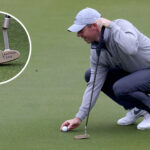Golf, a game of precision and skill, hinges on the ability to consistently drive the ball straight. This article is a comprehensive guide for golfers at all levels, aiming to improve the accuracy and distance of their drives.
Understanding the Basics
Before diving into techniques, it’s essential to understand the basics of a golf swing. The swing can be broken down into several key components: grip, stance, backswing, downswing, and follow-through. Each element plays a crucial role in the trajectory and accuracy of the drive.
Perfecting Your Grip
The grip is the golfer’s only physical connection to the club. A neutral grip, where the hands are positioned neither too far left nor right on the club, is often recommended for straight drives. Ensure that your grip is firm yet relaxed to avoid excessive tension.
Your stance should be balanced and stable. Feet should be shoulder-width apart, with the ball aligned with the inside of your lead foot. Proper alignment is critical; your feet, hips, and shoulders should be parallel to the target line.
The Backswing
The backswing sets the stage for a powerful and accurate shot. Focus on a smooth, controlled backswing, keeping your lead arm straight. The backswing should be a rotation of the shoulders and hips, rather than just the arms.
The Downswing
The downswing is where power and precision are executed. Initiate the downswing with your hips, followed by your shoulders, arms, and finally the club head. This sequential motion is key to generating power while maintaining control.
Impact and Follow-Through
At impact, your body should be in a position to transfer energy efficiently to the ball. Your lead wrist should be flat, and your back wrist slightly bent. The follow-through is as important as the swing itself. Continue rotating your body until your chest faces the target, ensuring a complete and balanced follow-through.
Common Mistakes and How to Avoid Them
Slicing: Often caused by an open clubface at impact. Ensure your grip and clubface alignment are correct.
Hooking: Usually a result of a closed clubface. Again, pay attention to grip and alignment.
Loss of Power: This can occur due to improper weight transfer or early release of the club. Focus on the sequence of your swing and maintain a steady tempo.
Practice Drills
The Tee Drill: Practice driving with tees at various heights to improve your adaptability.
Alignment Drill: Use alignment sticks on the ground to practice your stance and swing path.
The Pause Drill: Pause at the top of your backswing before completing your swing. This helps in developing a more controlled and powerful downswing.
Driving a golf ball straight is a skill that requires practice, patience, and a good understanding of swing mechanics. By focusing on the basics of grip, stance, and swing technique, and by being aware of common pitfalls, you can greatly improve your driving accuracy. Remember, every golfer’s swing is unique, so it’s important to find what works best for you. With dedication and practice, the art of driving a golf ball straight will become a rewarding part of your golf game.
Equipment and Ball Selection
In addition to technique, the right equipment can significantly impact your ability to drive a golf ball straight. When selecting a driver, consider its loft, shaft flex, and clubhead size. A higher lofted driver can reduce sidespin, leading to straighter shots. Similarly, a shaft that matches your swing speed ensures better control. Golf ball selection is also crucial; balls with lower spin rates can help reduce hooks and slices.
Mental Preparation and Focus
Golf is as much a mental game as it is physical. Mental preparation and focus are essential, especially when driving the ball. Before each shot, visualize the ball’s flight path. Stay calm and focused, avoiding overthinking or rushing your swing. Consistency in your mental routine is as important as consistency in your physical routine.
Physical Fitness and Flexibility
A golfer’s physical fitness and flexibility greatly affect their ability to drive the ball straight. Core strength, flexibility, and overall fitness can improve swing mechanics and reduce the risk of injury. Incorporating golf-specific exercises into your fitness routine can enhance your driving performance.
Learning from the Pros
Watching professional golfers can provide valuable insights. Notice their routines, how they approach the ball, their swing mechanics, and how they handle pressure. While their techniques might not be directly replicable for amateur golfers, there are always small tips and tricks that can be adapted to your game.
Regular Practice and Patience
As with any skill, regular practice is key to improvement. Spend time on the driving range, but also practice on different courses under various conditions. This experience is invaluable. Be patient with your progress; golf is a challenging sport where even small improvements can take time.
Seeking Professional Help
If you’re struggling to improve your driving skills, consider seeking professional help. A certified golf instructor can provide personalized guidance and feedback, helping you identify and correct specific issues in your swing.
Mastering the drive is a journey that involves a combination of technique, equipment, mental strategy, physical fitness, and continuous practice. By understanding and working on these elements, you can improve your ability to drive a golf ball straight, thereby enhancing your overall golf game. Remember, every day on the golf course is an opportunity to learn and improve. Keep practicing, stay focused, and enjoy the process of becoming a better golfer.
Frequently Asked Questions about Driving a Golf Ball Straight
Why do I keep slicing the ball?
A slice is typically caused by an open clubface at impact, which imparts sidespin on the ball. This can be due to incorrect grip, poor alignment, or an outside-in swing path. Focus on ensuring a neutral grip, proper alignment, and an inside-out swing path.
How important is the choice of driver in hitting a straight drive?
The choice of driver is quite important. A driver with the right loft, shaft flex, and clubhead size for your swing can significantly improve accuracy and distance. However, technique and practice are equally important.
How can I increase the distance of my drives while maintaining accuracy?
Increasing distance without sacrificing accuracy involves improving your swing mechanics for greater efficiency and power. Work on your core strength, flexibility, and ensure proper weight transfer during your swing. Also, make sure you’re using a driver that suits your swing style and speed.
How do I correct a hook in my drive?
A hook is often caused by a closed clubface at impact. Check your grip (it might be too strong), and ensure your stance and alignment are correct. Practice with a focus on maintaining a square clubface through the swing.
Is it better to have a harder or softer grip when driving the ball?
A grip that’s too tight can restrict wrist movement and reduce power, while a grip that’s too loose can lead to a lack of control. Aim for a firm but relaxed grip, where you have control over the club without excess tension.
How does my stance affect the direction of my drive?
Your stance sets up everything in your swing. If it’s not balanced or properly aligned, it can lead to issues like slicing or hooking. Ensure your feet, hips, and shoulders are parallel to the target line, and your weight is evenly balanced.
Should I use a different swing for driving than for other shots?
While the basic mechanics of the swing are similar across different shots, a drive typically involves a wider stance and a fuller swing with more emphasis on power. However, the core principles of a good swing – balance, rhythm, and control – remain consistent.
How often should I practice my driving to see improvement?
Consistency is key in practice. Ideally, practice your driving at least 2-3 times a week. However, quality of practice is as important as quantity. Focus on deliberate practice, where you’re not only hitting balls but also working on specific aspects of your swing.
Can technology like golf simulators help improve my drive?
Yes, technology like golf simulators can be extremely useful. They provide feedback on swing speed, ball trajectory, spin, and other data that can help you understand and improve your drive.
How do weather conditions affect driving the ball straight?
Weather conditions like wind, humidity, and temperature can all affect ball flight. For instance, hitting into the wind requires adjustments in club selection and swing power. It’s important to practice in various conditions to learn how to adjust your swing accordingly.







